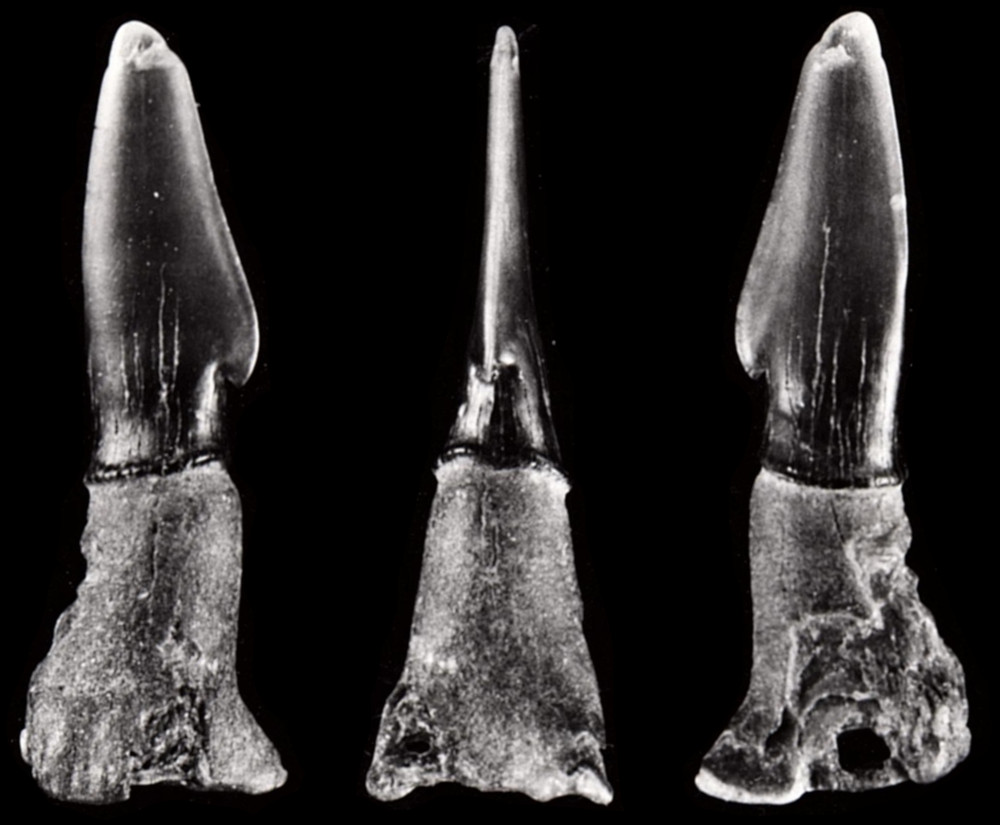Sclerorhynchus pettersi
Case & Cappetta, 1997
Classification: Elasmobranchii Rajiformes Sclerorhynchidae
Reference of the original description
A new selachian fauna from the Late Maastrichtian of Texas (Upper Cretaceous/Navarro Group; Kemp Formation). Münchner Geowissenschaftliche Abhandlungen Reihe A, Geologie und Paläontologie, 34, 131–189, 10 fig., 15 pl.
A new selachian fauna from the Late Maastrichtian of Texas (Upper Cretaceous/Navarro Group; Kemp Formation). Münchner Geowissenschaftliche Abhandlungen Reihe A, Geologie und Paläontologie, 34, 131–189, 10 fig., 15 pl.
Synonyms / new combinations and misspellings
Sclerorhynchus cf. pettersi
Sclerorhynchus cf. pettersi
Description:
Citation: Sclerorhynchus pettersi Case & Cappetta, 1997: In: Database of fossil elasmobranch teeth www.shark-references.com, World Wide Web electronic publication, Version 04/2024
Please send your images of "Sclerorhynchus pettersi" to info@shark-references.com

Sclerorhynchus pettersi Case & Cappetta, 1997 Holotype © G. Case

Sclerorhynchus pettersi Case & Cappetta, 1997 Holotype © G. Case
Distribution Geographic
South Sulphur River, near Commerce, Hunt County, Texas [401]; one mile southeast of Arneytown, Monmouth County, New Jersey [404]
South Sulphur River, near Commerce, Hunt County, Texas [401]; one mile southeast of Arneytown, Monmouth County, New Jersey [404]
Distribution Strategraphy
Late Maastrichtian (Navarroan), Kemp Clay Formation [401]; Late Maastrichtian (New Egypt Formation) [404]
Late Maastrichtian (Navarroan), Kemp Clay Formation [401]; Late Maastrichtian (New Egypt Formation) [404]
Description
Diagnosis after CASE & CAPPETTA, 1997 [401]: Rostral teeth of a Sclerorhynchus design but with a well differentiated posterior barb a little bit above the basal bulge. Oral teeth very low, with a cusp strongly bent lingually. Labial face very developed and bearing some radiating folds some of them dividing before the labial margin. Root slightly higher than the crown; root lobes wide with a flat basal face. There is a pair of large margino-lingual foramina.
Diagnosis after CASE & CAPPETTA, 1997 [401]: Rostral teeth of a Sclerorhynchus design but with a well differentiated posterior barb a little bit above the basal bulge. Oral teeth very low, with a cusp strongly bent lingually. Labial face very developed and bearing some radiating folds some of them dividing before the labial margin. Root slightly higher than the crown; root lobes wide with a flat basal face. There is a pair of large margino-lingual foramina.
Remarks
shark-references Species-ID=6241;
Some authors described rostral spines in open nomenclature as Sclerorhynchus cf. pettersi, eg. Smith (1999) [2244] and Smith et al. (1999) [3462] from Belgium or Case et al. (2017) from the Peedee Formation of North Carolina, USA [25344]
shark-references Species-ID=6241;
Some authors described rostral spines in open nomenclature as Sclerorhynchus cf. pettersi, eg. Smith (1999) [2244] and Smith et al. (1999) [3462] from Belgium or Case et al. (2017) from the Peedee Formation of North Carolina, USA [25344]
References

Global impact and selectivity of the Cretaceous-Paleogene mass extinction among sharks, skates, and rays. Science, 379, 802–806
DOI: 10.1126/science.abn2080
A late Maastrichtian selachian assemblage from the Peedee Formation of North Carolina, USA. Vertebrate Anatomy Morphology Palaeontology, 3, 63–80

Fossil selachians from the New Egypt Formation (Upper Cretaceous, Late Maastrichtian) of Arneytown, Monmouth County, New Jersey. Palaeontographica, Abt. A, 261(4–6), 113–124

Les élasmobranches de la transition Paléocène-Eocène de Dormaal (Belgique) : implications biostratigraphiques et paléobiogéographiques. Bulletin de la Société géologique de France, 170(3), 327–334

Elasmobranches nouveaux de la transition Paléocène-Eocène de Dormaal (Belgique). Bulletin de l'Institut Royal des Sciences Naturelles de Belgique, 69, 173–185

A new selachian fauna from the Late Maastrichtian of Texas (Upper Cretaceous/Navarro Group; Kemp Formation). Münchner Geowissenschaftliche Abhandlungen Reihe A, Geologie und Paläontologie, 34, 131–189, 10 fig., 15 pl.

Global impact and selectivity of the Cretaceous-Paleogene mass extinction among sharks, skates, and rays. Science, 379, 802–806
DOI: 10.1126/science.abn2080
A late Maastrichtian selachian assemblage from the Peedee Formation of North Carolina, USA. Vertebrate Anatomy Morphology Palaeontology, 3, 63–80

Fossil selachians from the New Egypt Formation (Upper Cretaceous, Late Maastrichtian) of Arneytown, Monmouth County, New Jersey. Palaeontographica, Abt. A, 261(4–6), 113–124

Les élasmobranches de la transition Paléocène-Eocène de Dormaal (Belgique) : implications biostratigraphiques et paléobiogéographiques. Bulletin de la Société géologique de France, 170(3), 327–334

Elasmobranches nouveaux de la transition Paléocène-Eocène de Dormaal (Belgique). Bulletin de l'Institut Royal des Sciences Naturelles de Belgique, 69, 173–185

A new selachian fauna from the Late Maastrichtian of Texas (Upper Cretaceous/Navarro Group; Kemp Formation). Münchner Geowissenschaftliche Abhandlungen Reihe A, Geologie und Paläontologie, 34, 131–189, 10 fig., 15 pl.
















